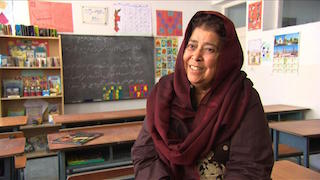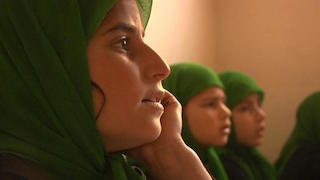Many documentary filmmakers turn to fundraising to finance their films. But not every filmmaker turns to fundraising to support the work of her subject. Producer/director Beth Murphy is using her film, What Tomorrow Brings, about visionary Razia Jan to help raise funds for what will be the first women’s college in rural Afghanistan.
Ray of Hope, a Massachusetts-based nonprofit committed to the education of girls in Afghanistan, is raising funds to build that college in the rural Afghan village of Deh Subz. In 2008, Ray of Hope founded the Zubali school, a K-12 girl’s school that offered the first ever opportunity for girl’s education in Deh Subz.
The filmmakers at Principle Pictures learned about the need for this college while filming the feature documentary What Tomorrow Brings, which is now in post-production. The film tells the story of the very first girls’ K-12 school in Deh Subz, Afghanistan, founded by the visionary Afghan American educator and Rotarian Razia Jan and her foundation, Razia’s Ray of Hope.
In an effort to further support the education of the young women featured, Principle Pictures has scheduled an Impact Campaign, where they will travel to various cities to show a work-in-progress version of the documentary.
“Making this film, and seeing what an impact the school has had on these girls and on their village, we’ve become so invested. We’re watching education make a difference, and we want to use our film to take this project to the next level,” said Beth Murphy, founder, Principle Pictures.
 Now the first class of students is graduating, but most of the girls, due to location, expenses, and conservative gender values, will be unable to attend college. Ray of Hope aims to change that by building the first ever women’s college in the village. The college will allow its students to specialize in nursing, midwifery, and engineering. All proceeds donated to Ray of Hope will go towards the construction of the school’s infrastructure, school supplies, and teacher salaries. For most women in this community, this college will be the only opportunity they have for continued education and job training.
Now the first class of students is graduating, but most of the girls, due to location, expenses, and conservative gender values, will be unable to attend college. Ray of Hope aims to change that by building the first ever women’s college in the village. The college will allow its students to specialize in nursing, midwifery, and engineering. All proceeds donated to Ray of Hope will go towards the construction of the school’s infrastructure, school supplies, and teacher salaries. For most women in this community, this college will be the only opportunity they have for continued education and job training.
Already, the girls in this community are experiencing enormous success in grades K-12. Since they began filming in 2009, they’ve witnessed the remarkable changes made possible by education:
Today, illiterate fathers who were leery about sending their daughters into the classroom now express pride that their little girls can help them read letters—even in English.
Today, the leading men in the community—the village elders—who once refused to look Jan in the eyes, now praise her efforts and support the school’s growth.
Today, girls who once were silent about forced engagements and early marriages are now speaking up and finding ways to negotiate more time in school.
 Jan wants to build on the incredible success of the high school she founded by creating the first college for rural girls in Afghanistan. The funds from this campaign will go directly to her foundation to build the school.
Jan wants to build on the incredible success of the high school she founded by creating the first college for rural girls in Afghanistan. The funds from this campaign will go directly to her foundation to build the school.
This project solves a seemingly intractable problem in Afghanistan – the lack of higher education opportunities available to girls in rural communities. And it does it in a way that makes sense for Afghanistan. This is not a western answer to an Afghan problem. It is an Afghan answer to an Afghan problem.
The K-12 school she opened in 2008 has an attendance rate of 93 percent, a retention rate of 96 percent, and has dramatically increased enrollment year after year (today serving more than 480 students). By the Afghan Ministry of Education’s metrics for administration, curricula, and facilities, the school is the top private school in the district. A representative from the Ministry is on record describing the school as “perfect.”
Students will graduate in two years with marketable, much-needed skills and the ability to work in schools, businesses, government, and health care—careers that are compatible with being a married, observant Afghan woman.
The new facility will include a medical clinic where midwifery students will train alongside doctors and midwives. This medical facility will have an enormous impact on a severely medically underserved area with no district hospital.
Supporters who are interested in backing this campaign, but are unable to attend a screening, can donate to the project’s Indiegogo campaign, which aims to raise $115,000, the minimum amount required to build the infrastructure needed.
Principle Pictures is running an Indiegogo campaign to raise funds for the Ray of Hope Foundation. Supporters can pre-order digital and hard copies of What Tomorrow Brings for as low as a $50 contribution. The campaign launched June 9. Backers can expect to receive the film after its film festival premiere in early 2016.
Indiegogo Campaign: http://bit.ly/1JEIPen
Build a School: http://buildaschooltoday.com/
Ray of Hope: https://raziasrayofhope.org/
Principle Pictures: http://www.principlepictures.com/
